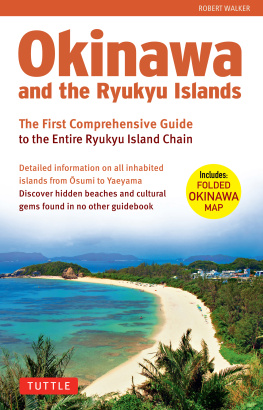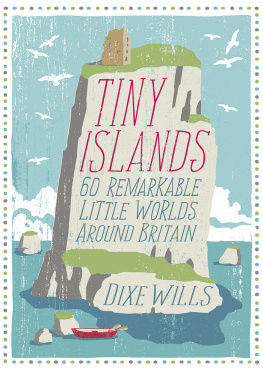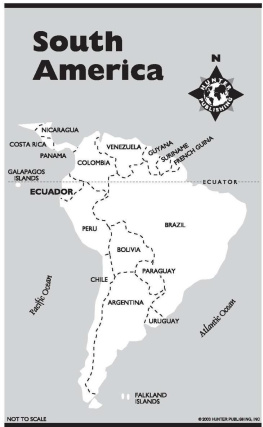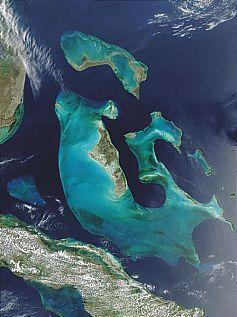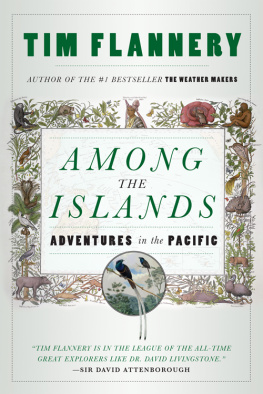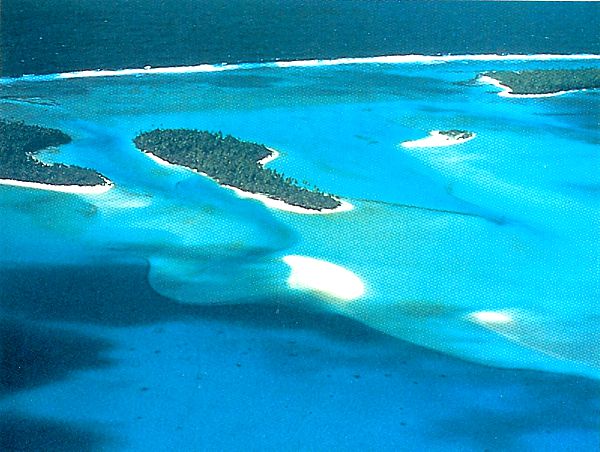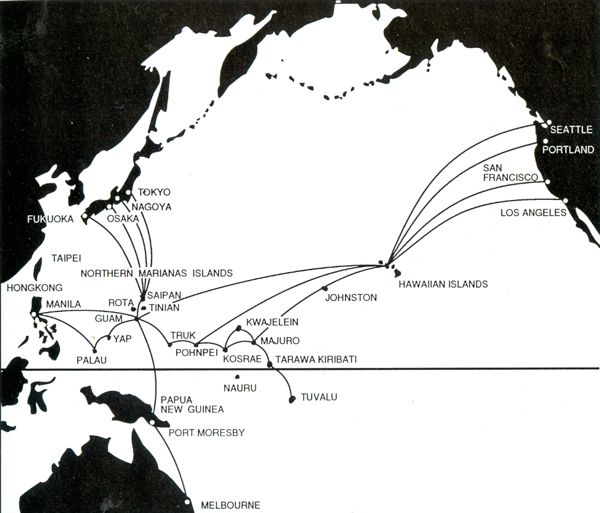Micronesia's Yap Islands, Palau & Kiribati - Another World
Thomas H Booth
Hunter Publishing, Inc.
INTRODUCTION
Micronesia is 2,147 islands surrounded by three million square miles of Pacific Ocean. Within this vastness, about the size of the continental United States, these "tiny islands" as the name Micronesia implies, include a total land area of 717 square miles. That's about the size of the state of Rhode Island, and certainly isn't much dry land in such an expanse of wet ocean. As to population, about 350,000 varied but handsome brown people live on 125 of these islands.
Geographically, the simplest reference we can make is to say that Micronesia lies mostly in the tropical North Pacific beyond the Dateline, roughly between Hawaii and the Philippines.
Physically, the first thing that comes to mind about these little-known islands is beauty. It's a tropically profound beauty associated with palm-clad islands, white sandy beaches, multi-hued gin-clear lagoons, and sometimes abrupt green mountains covered with jungle and laced with waterfalls.
The islands of Micronesia, of the entire Pacific, may be described as either high or low. Variations of each exist, but all fall into the following categories.
The Atoll is a coral reef, irregularly circular in shape, that forms a necklace of narrow islets. This complex, a living organism, has been created by volcanic activity, currents, winds, the growth of live coral polyps, over untold thousands of years. Usually no more than 16 feet above sea level, the ring of islets partially encloses a lagoon. The opening into the lagoon, generally on the leeward side, allows for the very careful passage of boats.
Atolls come in all sizes from mere dots of sea-washed coral with nothing on them except sea turtles and birds, to others that have enough exposed dry land to support a forest of tropical growth. Seen from the air for the first time, the size of atolls and their vibrant lagoons will startle you. Kwajelein, for example, is the biggest atoll in the world, and its lagoon encompasses 1,400 square miles of water.
Pacific atolls
The Raised Atoll has been pushed up higher than usual by submarine violence, usually volcanic. Such islands have hills, some as high as 200 feet above sea level. Because of the quality of soil, human life on raised atolls is often easier than on lower atolls.
The High Island is the exposed top of a submerged volcano. They're often very high, generally covered with jungle and drained by streams and waterfalls. Guam is a good example, as are Pohnpei, parts of Palau, Kosrae, and Chuuk.
THE PEOPLE OF MICRONESIA & THEIR HISTORY
We'll cover the history of each island group as we travel there but, as a generality, the origin of the Micronesians was probably near Malaysia. Historians suggest that these folks appeared in the Marshalls, Carolines, Marianas, Gilbert and Ellice Islands as early as 1500 B.C.
While there may have been more people scattered among these islands than there are today, there probably never was a "Golden Age" civilization. In spite of the presence of the Nan Madol ruins on Pohnpei, similar ruins on Kosrae, the Latte Stones on Guam, and the artifacts on Palau, these early inhabit ants did not build an impressive civilization.
Recorded history began with the sighting of some of these is lands by Magellan in the 16th century and, while successive Spaniards did little to colonize the islands, they did leave their religion behind.
Spain's rule, beginning in the 18th century, was ended by the Spanish-American War at the start of the 20th century. Germany, by purchase, took over much of the Marshalls, Northern Marianas, the Carolines and, while imposing a stern discipline, maintained a thriving copra (processed coconut meat) trade.
When World War I began, Germany, with more pressing matters at hand, departed. Then, under a League of Nations Mandate, the islands, except Guam, were entrusted to Japan. Like the Germans before them, they ran the islands with a firm hand, and the area became known as The Japanese Mandated Islands. Those are the years (1914-1945) that some Micronesians look back on with parodoxic nostalgia. They remember Japan as a harsh ruler, but the system worked, and so did the islanders. Today most adults over 47 still speak some Japanese.
During World War II many of these islands were in the news daily, and still remain in the memory of thousands of Americans and Japanese. Veterans of those days, of which I am one, who remember the pains of Tarawa, Peleliu, Guam, Saipan, Wake, and Midway, will on demand describe the lighter sides of the war. They'll recall the drinking of Government Issue warm beer on the Fleet Recreation Beaches of Mog Mog, Ulithi, Tinian, Guam, and Saipan. They'll recall the ludicrous landing of goony birds on Midway and Wake, and all of them will remember the ultramarine clarity of water in the lagoons.
Veterans will remember too that Guam was lost to the Japanese early in the war, then dramatically taken back in 1944. Still vivid to them are the battles fought at Saipan, Guam, Tarawa, and the long grinding conflict among Peleliu's limestone ridges (part of Palau).
At Chuuk, Japan's Gibraltar, an entire enemy fleet was at tacked by U.S. forces and sunk in the lagoon more of this later. And it was from Tinian in the Marianas, 125 miles north of Guam, that on August 6, 1945 the B-29 Enola Gay took off, set its course for. Japan, and dropped an atomic bomb on Hiroshima. That event and the subsequent attack on Nagasaki ended hostili ties with Japan.
With the defeat of Japan, the Marshalls, Marianas, and the Carolines became a United Nations Trust Territory of the United States and came under the paternalistic sway of the Department of the Interior. This new master did not have the missionary zeal of the Spaniards, the stern management of the Germans or the Japanese, and no real policy. However it did succeed in bringing a huge bureaucracy and attendant welfare state to life. But was any other arrangement possible? Some writers suggest that post-war administration of these islands posed problems. These bits of land suffering from the effects of war had no significant deposits of minerals, no sizeable agricultural land, no prominent work force, and unity among these far-flung island groups, where nine languages are spoken, was nearly absent. Can the United States government reduce welfare to Micronesia? The answer is "perhaps;" but considering that the islands have been dependent for over 40 years, it's unrealistic to say that welfare will be refused by those benefitting the most the islanders. In the future, perhaps painfully, self-reliance may reduce these needs.
Happily, that self-reliance may be developing. Trustee Status was never intended to be permanent. Micronesia now consists of four new states the Republic of the Marshall Islands, the Federated States of Micronesia, the Republic of Belau, and the Commonwealth of the Marianas Islands. Guam's status as an Unincorporated Territory of the United States remains the same.
Finally, as a footnote to Micronesian history, nearly everyone remembers that in 1952 the inhabitants of Bikini, an atoll near Enewetok, were relocated in order for the first hydrogen bomb to be tested. This resolution was not an entirely happy one and, because of nuclear contamination, conditions on and around Bikini for a long time were questionable.


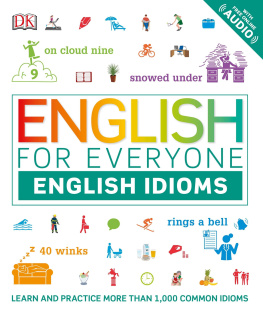
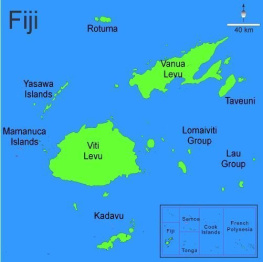

![Greek islands [2018]](/uploads/posts/book/209249/thumbs/greek-islands-2018.jpg)
